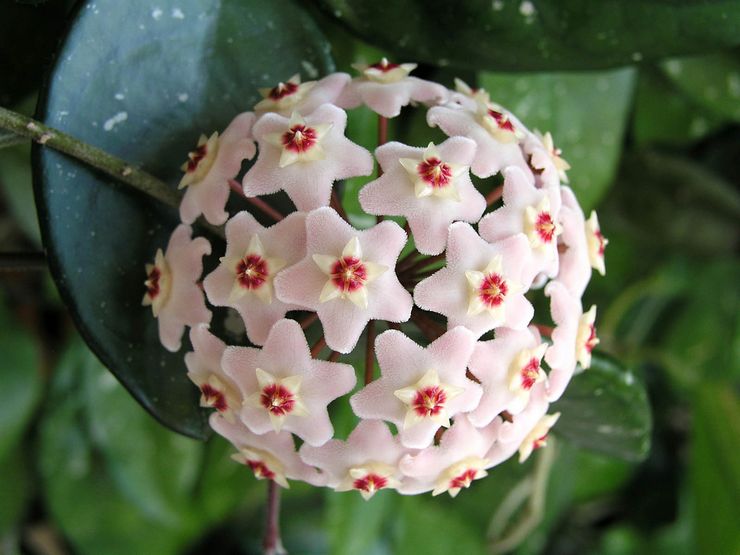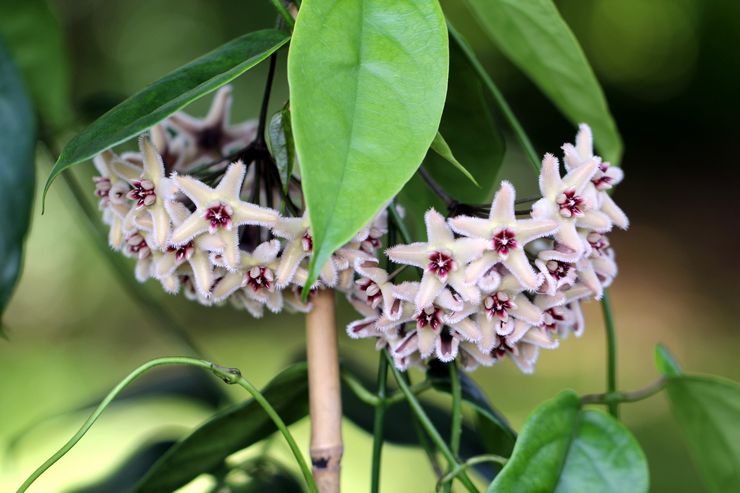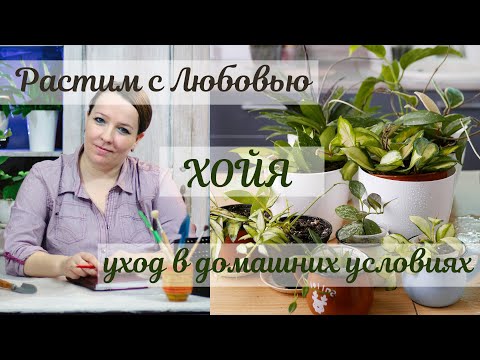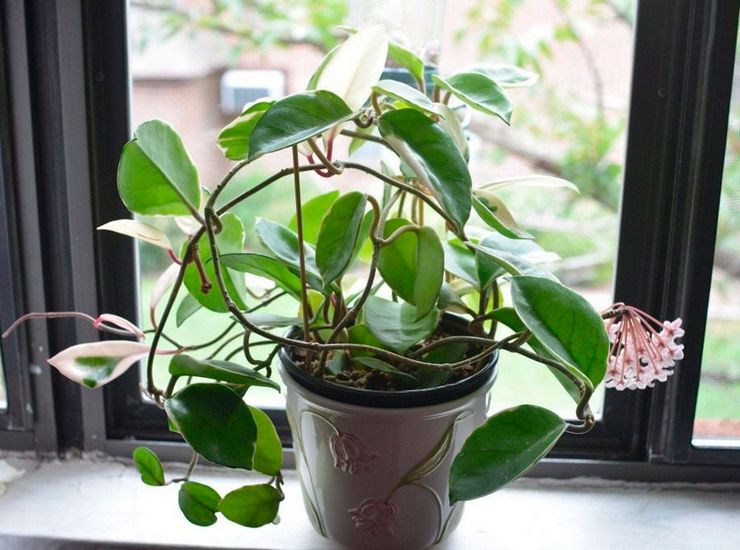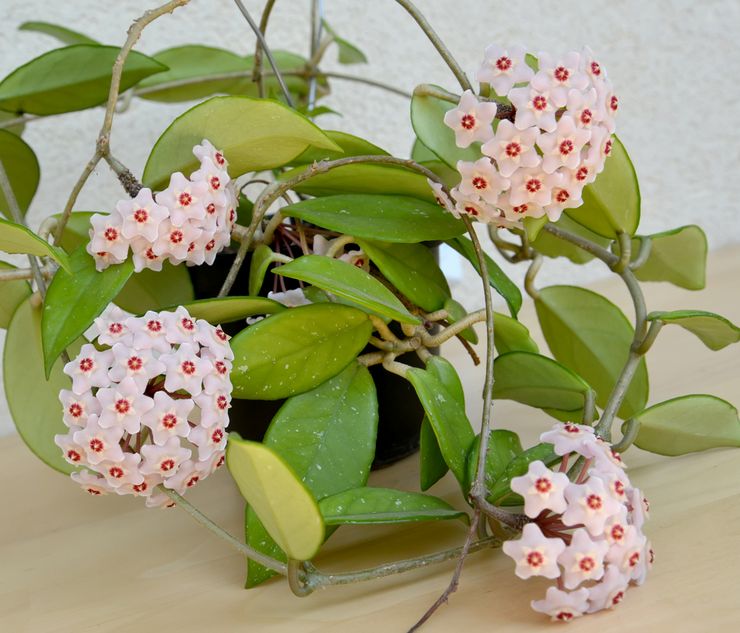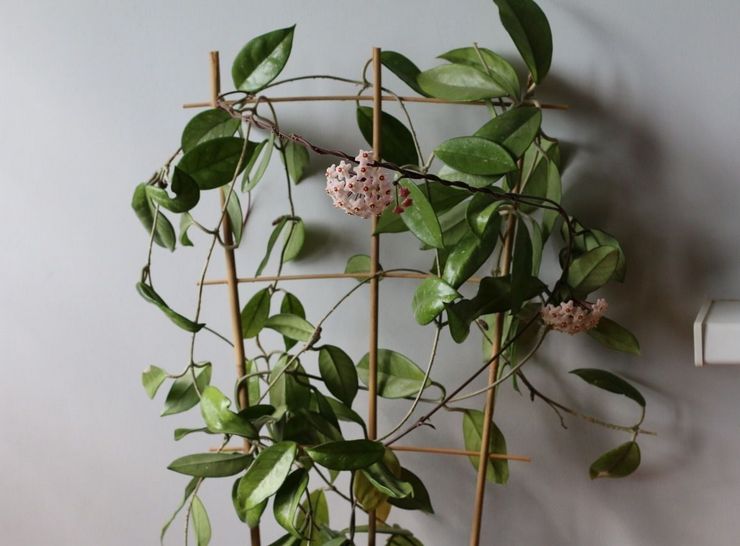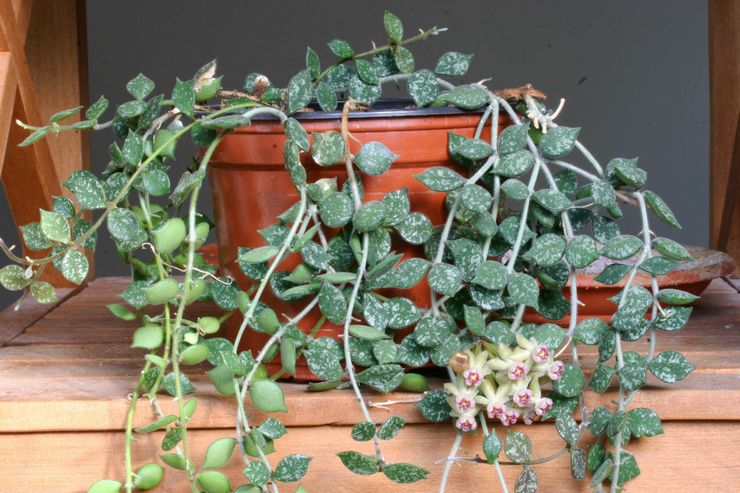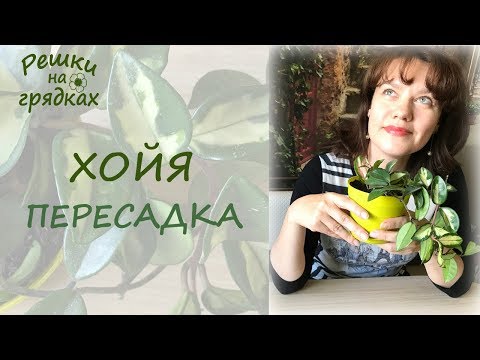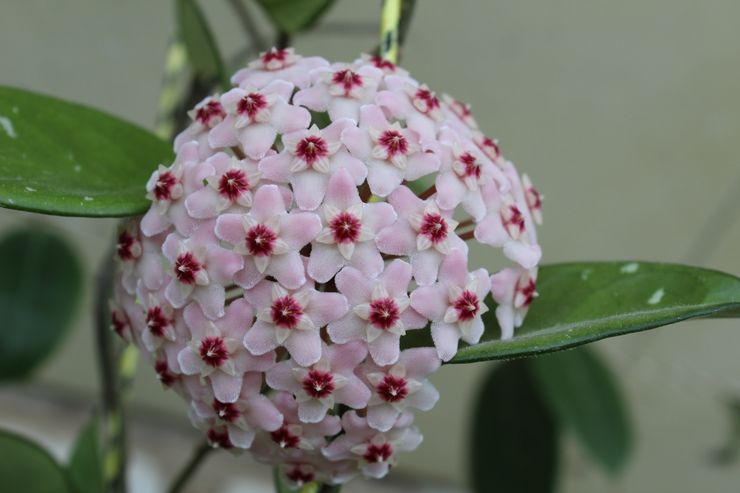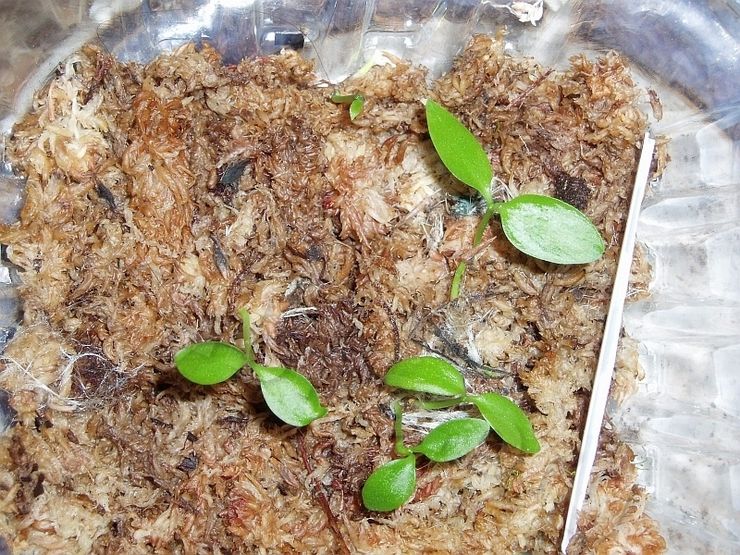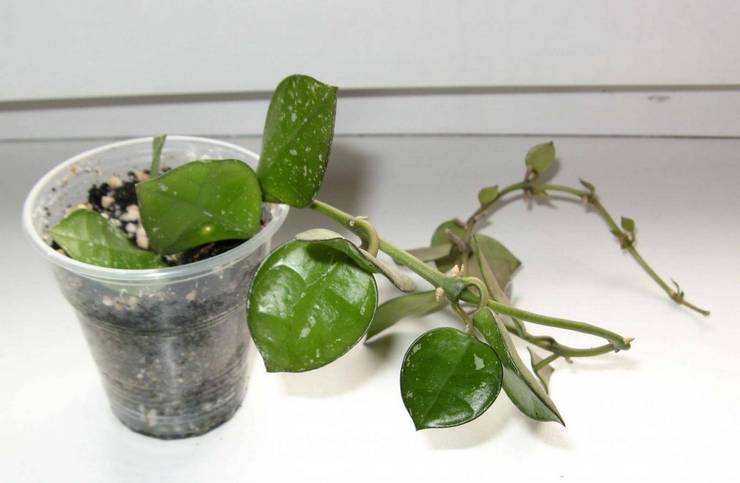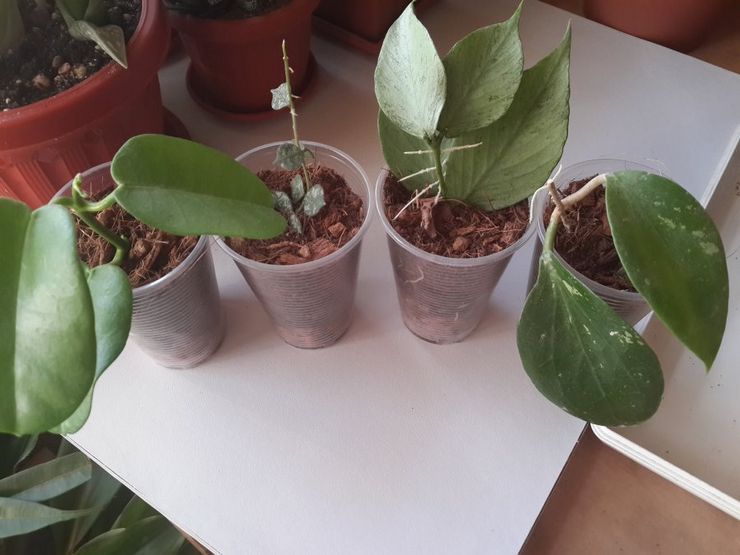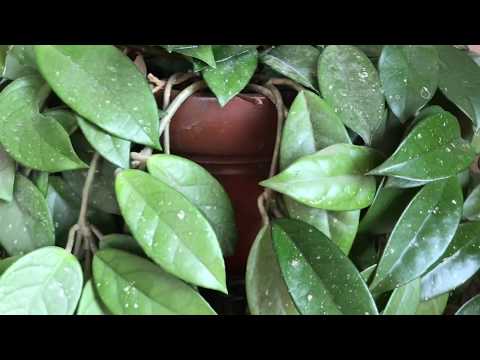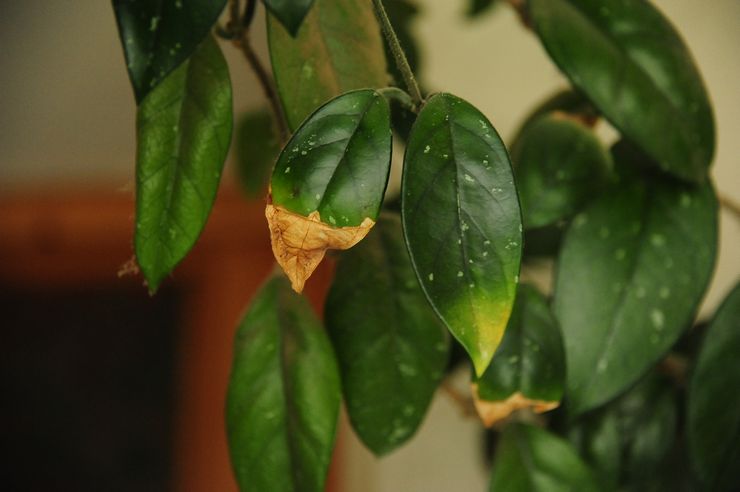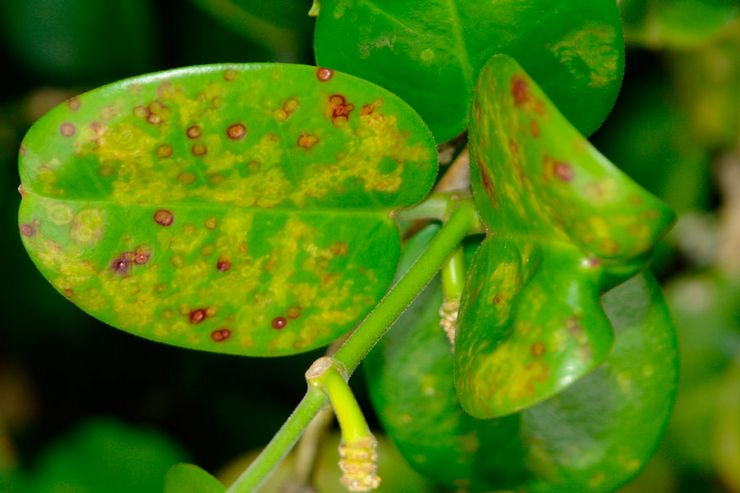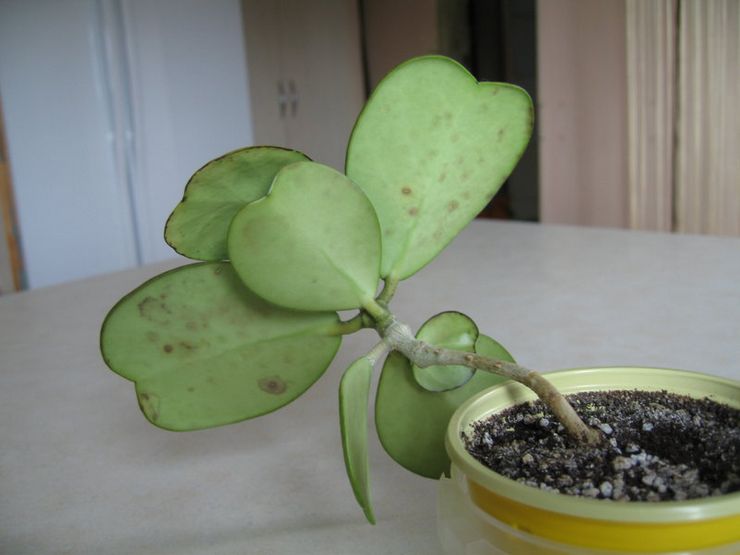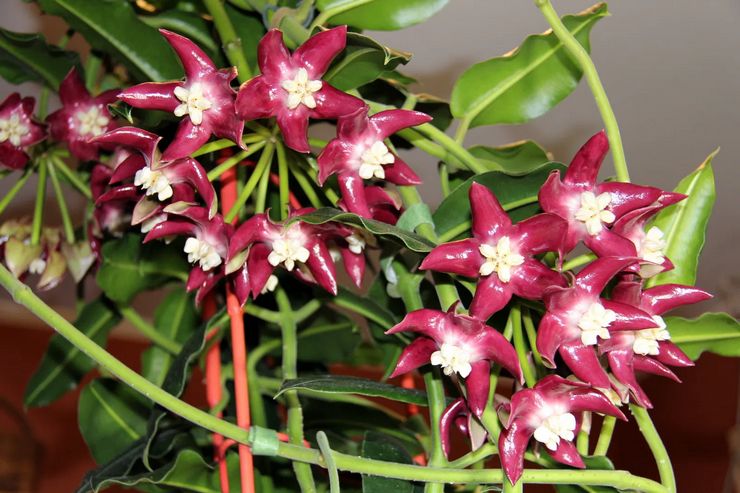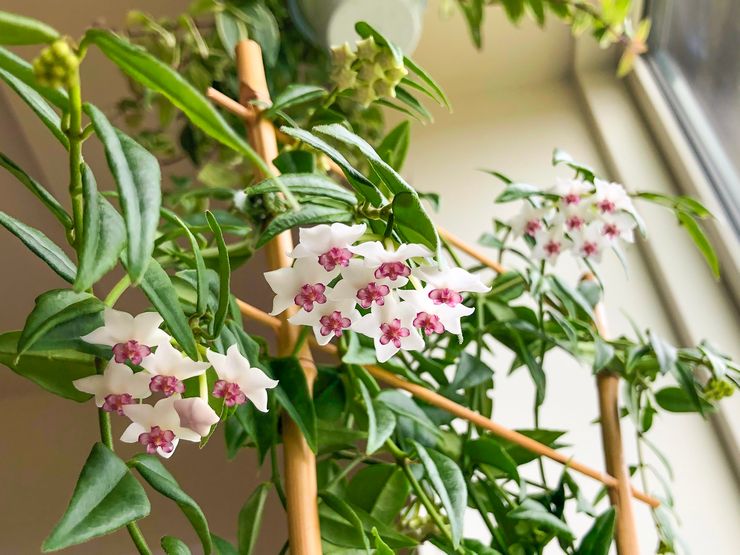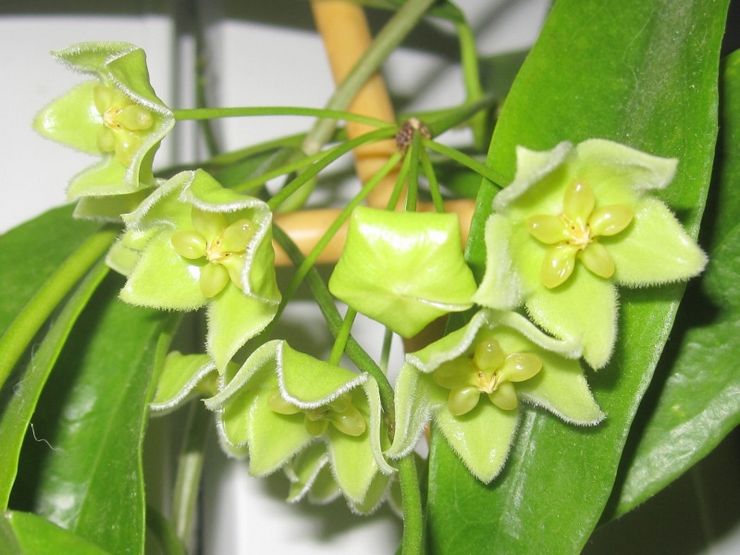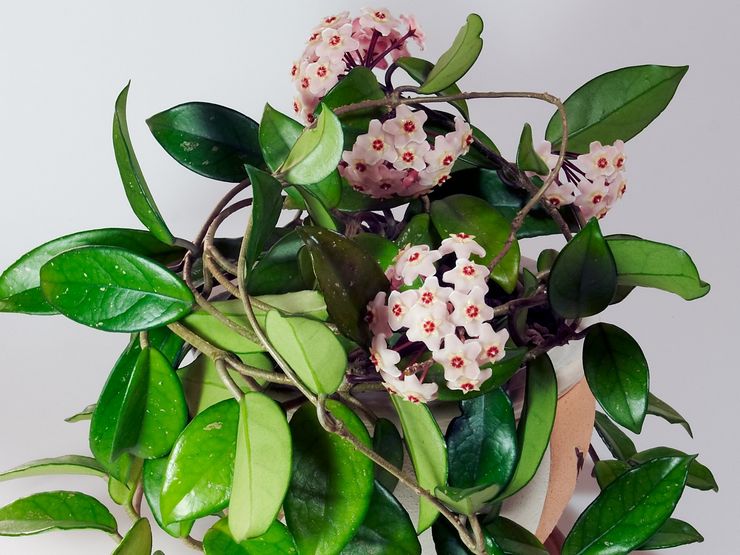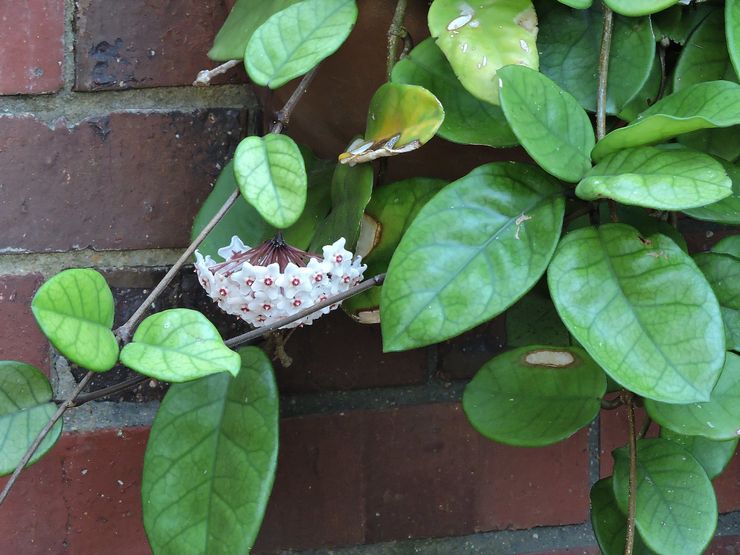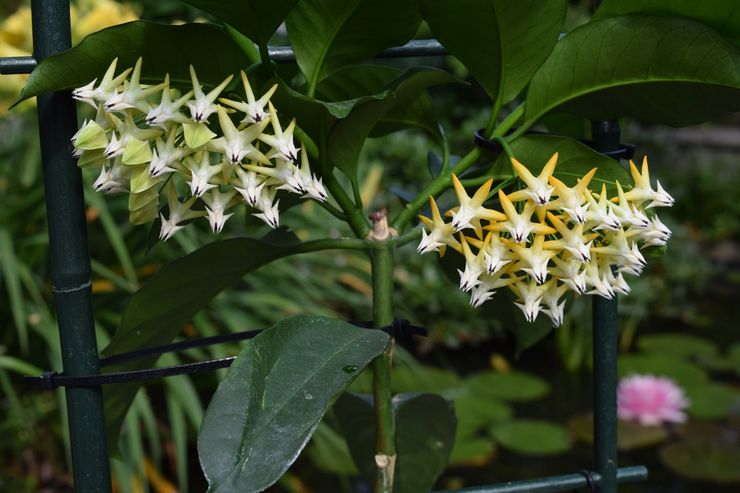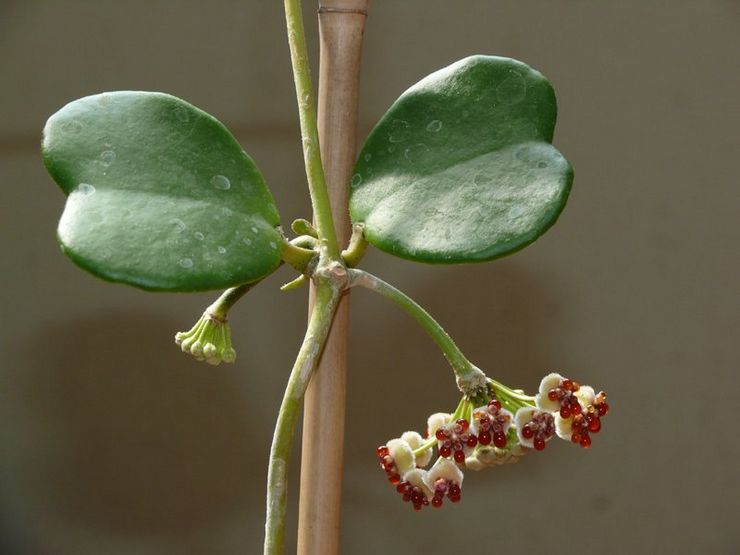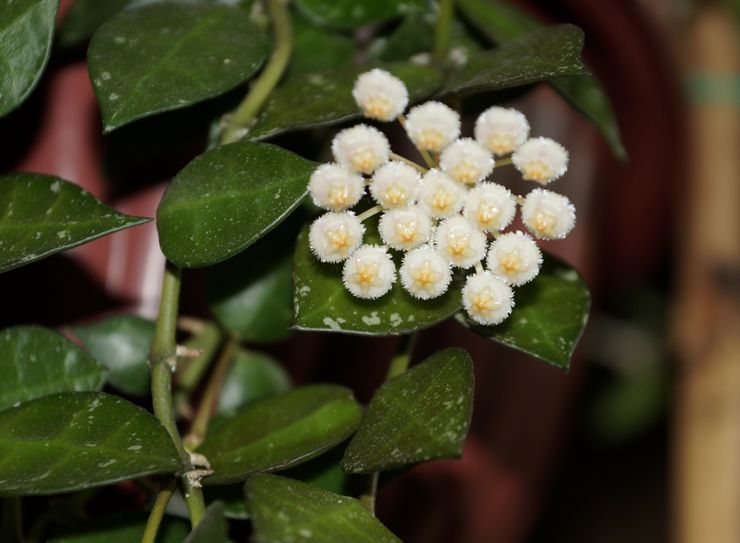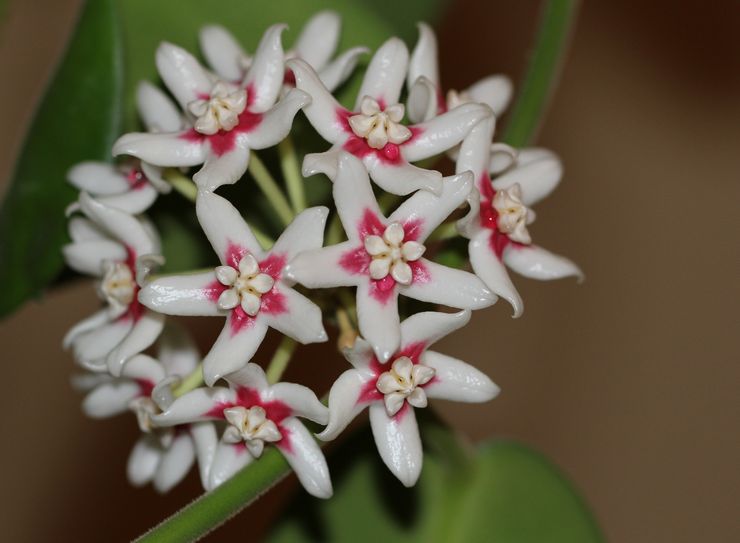The hoya plant (Hoya) is a liana from the Kutrov family, which belongs to the Lastovniev subfamily. Due to its appearance, this flower is also known as wax ivy. The Hoya genus unites over 200 different species. The name of the plant was given by the scientist Brown, at the beginning of the 19th century he named it after his friend, the Briton Hoya, who worked in the ducal greenhouse and bred tropical flowers.
The tropics are considered the homeland of the hoya. This evergreen plant is often found in Australia, as well as in Asian forests, the Canary Islands and the island of Madagascar. Lianas love to grow in open woodlands, where their shoots spread along the slopes and cling to the trees and shrubs encountered. Despite the fact that the hoya is often called ivy, she is not related to him..
Hoya description
Hoya is a liana, the length of shoots of which in nature can reach 10 m. Domestic specimens are smaller and usually do not exceed 5-6 m in length. Hoya’s young stems are purple-brownish in color. Foliage appears on them only over time. In addition to leaf blades, adult shoots form aerial roots. At the same time, their color changes to green, after which the stems begin to grow stiff. Hoya leaves oppositely located have a leathery, as if waxy surface with grayish blotches. This feature gave the flower its popular name – wax ivy. The size of the leaves and their color can vary depending on the specific species. Fresh blades usually have a shiny surface, but become dull as they grow. In some species, pubescence is present on the leaves. The leaves themselves can be in the shape of an oval, egg or heart..
During the flowering period of the hoya, fleshy umbrella-shaped inflorescences appear in the axils of the shoots. They may include about fifty small flowers with 5 petals. The shape of the flowers may vary. On average, the size of each flower is about 1-2 cm in diameter, although in the imperial species they reach 6 cm. In the middle of the corolla there is a “crown” rising above the petals, formed by the fused parts of the flower. Most often, it has a color different from the petals. The petals usually look velvety. Their color includes delicate shades of white, pink, greenish and brown. After flowering of one flower (they stay on the bushes from several days to 3 weeks), another is formed in its place. The flowering period itself lasts from May to October. Hoya flowers are fragrant and form a lot of nectar, so the plant is considered melliferous. Nectar production peaks in the evening and at night, when the scent that attracts insects becomes most noticeable. Different types of umbrellas smell differently..
Unpretentiousness, large green mass and original flower shape make hoya one of the most common home flowers. Hoya is also loved by esotericists, who believe that liana helps to improve energy in the room and can extinguish conflicts. Due to its unpretentiousness and spectacular appearance, this plant is often used to decorate offices. But still, there are limitations in growing hoya. The flower is poisonous – its juice can cause irritation, so all manipulations with the plant are carried out with gloves, and also remove it away from children and pets. With proper care and careful handling, the vine can perfectly coexist with other plants and does not cause harm. But allergy sufferers and sensitive people should be careful with especially fragrant types of flowers. During full bloom, the concentrated smell of inflorescences sometimes causes migraines or allergic attacks..
Hoya – home care. Watering, soil, reproduction, diseases and pests.
Brief rules for growing hoya
The table shows brief rules for caring for hoya at home..
| Lighting level | Light partial shade is considered optimal for growing hoya.. |
| Content temperature | The optimal temperature for the growth and development of vines is considered to be an interval of 20-30 degrees.. |
| Watering mode | During flowering – from late spring to October, hoya is watered regularly, but not too abundantly. Usually one watering per week will be sufficient for the plant.. |
| Air humidity | Most species are not too demanding on the level of humidity, so usually the liana is satisfied with ordinary room air.. |
| The soil | Hoya needs a loose and breathable soil of a neutral or slightly acidic reaction, although some species prefer a slightly alkaline soil. |
| Top dressing | A large number of hoya stalks require a sufficient supply of nutrients. The entire growing season, the liana is fed with liquid mineral compositions. |
| Transfer | Young, more actively developing plants need to be transplanted into a new pot every spring. Adult bushes are transplanted into new pots not so often – once every 3-4 years. |
| Pruning | Hoya usually does not need frequent pruning or pinching.. |
| Bloom | The timing and abundance of flowering vines depend both on temperature and on the level of illumination.. |
| Dormant period | The winter dormant period of the vine is conditional – the plant only slows down the growth rate, without stopping it altogether. |
| Reproduction | Cutting, dividing a bush, seeds, leaf propagation. |
| Pests | Root nematode, aphid, mealybug, spider mite. |
| Diseases | Powdery mildew, gray mold, viral and bacterial infections. |
Hoya care at home
Of the variety of hoya species, the most popular are the beautiful and fleshy ones, the latter of which is considered one of the most unpretentious. Although each species and variety may have its own preferences, there are general rules for growing such vines. Since the tropics are the homeland of this culture, they try to recreate similar conditions at home for hoya. Only in this way can the liana become as decorative as possible..
If hoya is bought in a store, they try to choose a well-developed and strong bush without signs of pests and with dense, brightly colored leaves..
Lighting
The choice of a permanent place for the hoya has a significant effect on its flowering. In the wrong corner, the inflorescences on the bush will never appear. They try to choose a place for the plant right away – the liana does not like unnecessary permutations, and the constant movement of the pot can provoke the dropping of foliage and buds.
Light partial shade is considered optimal for growing hoya. On the eastern or western windows, the vine grows well and blooms for a long time and magnificently. On the south side, the flower pot is kept away from the window or shading agents are used to protect the shoots from direct scorching rays. In such rooms, hoyu can be grown on the wall – long shoots on mounts can become an additional decoration of the interior..
Despite the size of the stems, it is not recommended to use hoya for landscaping a balcony or veranda in the summer. In direct light, the bush will develop worse. In winter, during the dormant period, they try to keep the flower away from heating appliances. High temperature and dry air can be detrimental to hoya..
Most species of creepers require a fairly long daylight hours. If the beginning of flowering fell on prolonged cloudy weather, it is recommended to illuminate the bush with phytolamps, bringing the duration of daylight hours to at least 12 hours. In winter, this time can be reduced to 10 hours..
Some features of the hoya also affect its placement. The scent of its many flowers indoors can become too strong, so the flower should not initially be placed in the bedroom or other resting places. Only frequent airing will help to avoid the undesirable effect..
Even on one hoya bush, many long stems can form. For the convenience of growing and giving the shoots of the vines more decorativeness, supports are acquired for the hoya. They can have literally any shape you like – arcs, arches, lattices, any figure, etc. Flexible stems are tied to supports, giving them the desired direction. Sometimes hoyu is formed in the form of a small shrub, achieving the desired effect with regular pinching..
Temperature
The optimal temperature for the growth and development of hoya is considered to be an interval of 20-30 degrees. But in addition to heat, the plant also needs air movement, so the room with the hoya should be systematically ventilated. But you should not expose the pot to streams of cold air – hoya does not like drafts.
In winter, the temperature in the room can be lowered a little – the coolness of up to 15 degrees is considered comfortable for the hoya, but if the room is 10 degrees or less (the exact threshold depends on the species), the thermophilic vine may die. Hypothermia also leads to yellowing and shedding of its foliage. Moderately cool wintering, in turn, will contribute to the abundant flowering of the bush next summer. The optimum temperature at this time is considered to be about 16-18 degrees. At the same time, the winter period of dormancy of the vine is conditional – the plant only slows down the growth rate, without stopping it completely.
Watering
During flowering – from late spring to October, hoya is watered regularly, but not too abundantly. Typically, one watering per week will be sufficient for the plant. Water for hoya is defended for at least a day. Excess liquid from the pallet must be poured out – waterlogging of the soil can lead to the development of diseases. Before the next watering, the soil should have time to dry out by about 1-2 cm.
With the arrival of November, the volume of irrigation is reduced. After the top layer has dried, it is kept for another 2-3 days, watering the bush about once every couple of weeks. If the vine hibernates in the cool, for this period watering is sometimes stopped altogether, moistening the soil only if necessary. Excessive moisture in the soil coma in such conditions quickly leads to the death of hoya roots, which is why the plant weakens significantly by spring.
Hoya can be bathed a couple of times a year. This is done before flowering and after flowering, until the vine has become particularly sensitive to transfer. The flower pot is placed in a basin of water at a temperature of about 35 degrees. The shoots are kept in water for about 7-10 minutes, and the pot itself is left in it for about 30-40 minutes. Spring bathing promotes a quick onset of flowering and also improves the growth rate of the hoya. The autumn procedure hardens the plant and allows it to gain strength before the upcoming winter..
Humidity level
Most types of hoya are not too demanding on the level of humidity, so usually the liana is satisfied with ordinary room air. But its excessive dryness can still be harmful to the plant. During such periods, hoya can be placed on a pallet with damp pebbles or sprayed on its foliage..
It is also possible to wipe or spray the liana foliage for sanitary purposes: it is periodically cleaned of dust, contributing to the improvement of metabolic processes inside the leaf. But during the flowering period, spraying is not recommended..
The soil
Hoya needs a loose and breathable soil of a neutral or slightly acidic reaction, although some species prefer a slightly alkaline soil. In general, the plant is not too demanding on the composition of the potting mix. For hoya, peat soil, including turf, leafy soil and sand, is well suited. It is recommended to add a little crushed sphagnum moss and a handful of charcoal to the finished substrate. For vines, you can also use ready-made mixtures for orchids or violets..
Top dressing
A large number of hoya stalks require a sufficient supply of nutrients. During the entire growing season, the liana is fed with liquid mineral compositions. Fertilizers are suitable for orchids and flowering succulents. They are introduced into the soil once every couple of weeks, calculating the dosage according to the instructions. By adjusting the composition of nutritional supplements, it is possible to achieve green mass growth or more lush flowering. In this case, it is better to slightly underfeed the flowers than to allow an excess of nutrients. Excessive fertilization will adversely affect the health and beauty of the bush. If the hoya was recently transplanted into the nutrient soil, top dressing begins only after 2-3 months. In winter, when the bush is resting, no fertilizer is applied.
Transfer
Hoya – Wax Ivy Transplant Care
Hoya grows very quickly: during the year its shoots grow about 30 cm in length, the roots also have an increase, but compared to the size of the stems, their volume is not so great. Young, more actively developing plants must be transplanted into a new pot every spring, 2-3 cm larger than the previous one in diameter. If the hoya pot is free, the growth rate of the vines will increase, but a slightly tight container will allow the plant to bloom more profusely. Using this feature, during transplantation, you can pre-regulate the growth rate and formation of inflorescences. Adult bushes are transplanted into new pots not so often – only once every 3-4 years. For a mature bush, a pot of about 18-20 cm in diameter is optimal..
When transplanting hoya, they use the transshipment method, moving the plant along with the soil clod – the roots of the liana are quite fragile. At the same time, they try to replace the upper part of the soil. At the bottom of the new pot, it is important to make a good drainage layer – about 1/3 of the total volume. Usually for this they take expanded clay, shards or other similar material. If a liana needs a transplant as part of treatment, the root system is carefully cleaned of old soil, and then carefully examined, removing damaged or rotten roots. All places of cuts are powdered with crushed coal. The bush treated in this way is ready for transplanting into fresh soil.
When growing hoya, attention should be paid to the material from which its container is made. Ceramic pots are best suited for lianas, which provide air flow to the roots of the plant. They should also have drainage holes. Any new pot should be disinfected before placing the flower in it. If the hoya was bought in a store, has a container of a suitable size and does not get sick, such a bush is transplanted only after flowering ends or in the spring of next year. Liana can also be grown hydroponically.
Pruning
Hoya usually does not need frequent pruning or pinching. When young shoots form 4 leaves, they are pinched to stimulate the development of new stems. If some of the hoya twigs are too long, they are pruned. Use a pruning shear or other sharp and clean tool to trim. The cut is made in the interval between the nodes. After pruning, the bushes become more lush and bloom better. Unlike many other crops, after flowering, the umbrellas are not removed, but left on the branches, waiting for the formation of new buds.
When trimming the hoya, precautions must be taken – the plants abundantly secrete milky juice, which is considered poisonous. After working with a flower, be sure to wash your hands. If the juice gets into the eyes, they are also washed, and if necessary, consult a doctor.
Bloom
The timing and abundance of hoya blooms depend on both temperature and light levels. If the bush does not lack light, numerous umbrellas will form on it..
During the period of bud formation and for the entire flowering period, the bush becomes especially sensitive to changing conditions, and especially to permutations. A disturbed plant begins to shed buds and flowers, which is why a place for a bush is chosen in advance and for sure, and they also try not to touch the stems with flowers unnecessarily and not turn the pot. In this case, shoots with inflorescences should be placed vertically on supports, heavy inflorescences of some species sometimes require the use of props. After flowering, too long hoya stalks are cut off, leaving short and flowering ones – flowers will appear on them next year. Pruning such branches will significantly postpone the timing of the appearance of new flowers. At the same time, the peduncles themselves are not removed either – until the umbrellas have fallen off on their own, new buds may form on them some time after the old flowers wither. Some species do not have this feature. For example, in the beautiful hoya, the inflorescences fall off immediately, and in the multi-flowered one – after the second wave of flowering.
Hoya breeding
You can get young hoyi at home using various methods. For vegetative propagation, the entire period of vines activity is suitable, with the exception of the flowering wave..
Growing from seeds
This breeding method is not very popular due to its complexity. Hoya seeds at home, due to the lack of familiar pollinators, are tied very rarely, and are also practically not found on the market. Most often, seed reproduction is resorted to in greenhouses, where more comfortable conditions are created for plants..
Seeds are formed after the umbrella has flowered. The percentage of their germination is initially not too high – only properly ripened seeds can germinate. They are sown no later than a year after collection, after this period the probability of their germination drops significantly. Seeds are sown in a mixture of ordinary soil with sphagnum moss and placed in greenhouse conditions in a bright place. The soil in the container should remain slightly damp, but not damp. The greenhouse is periodically opened for ventilation. The first shoots should appear in a week, but they will develop slowly. To protect seedlings from fungal infections, they are treated with a copper-containing fungicide according to the instructions. Small plants will not need feeding. The seedlings should form their first foliage 3 months after germination. When this happens, sufficiently strong hoyi can be cut into their own pots..
Reproduction by layering
This method attracts flower growers with its lightness and almost guaranteed result. Hoya obtained from cuttings bloom in the first year of cultivation..
To form a layering, a bush is chosen, the shoot of which can be laid in another container standing next to it. It is filled with nutrient soil, which includes peat. The selected shoot with a knot is fixed in an adjacent pot with a hairpin. At the same time, a small incision is made in the place of future rooting, and then it is covered with sphagnum in several layers. After watering, the layers are covered with a film. Both containers – with the old bush and layering – should stand in a warm and bright place next to each other. They are left in this position until the shoot forms its own roots and fresh foliage. The resulting young plant is separated from the old one by cutting off the stem that connects them, and then transplanted into a pot of a suitable size.
Layers can be obtained in another way. In the place of the incision, the selected stem is wrapped in wet moss, wrapped in foil and fastened with twine. In greenhouse conditions, roots soon form from the incision. When they reach a suitable size, the stem is cut off and transplanted into a separate pot..
Cuttings
Hoya cuttings are also considered one of the easiest and easiest methods to get new vines. On last year’s shoot, a segment is chosen that has 3 internodes and 2-3 pairs of leaves. Places of cuts on the resulting cuttings are treated with garden varnish or powdered with coal. For rooting, cuttings are placed in water or immediately planted in the ground. To be sure to multiply hoya, they are usually cut into several pieces at once. If the branches are in water, a root pruning stimulant should be added there, as well as a little activated carbon to protect against diseases. The water itself must be settled and at room temperature. You can cover the glass with a handle with a bag, but it will need to be removed from time to time for airing. The root formation takes about 2-3 weeks. The cuttings are planted in separate pots when they are properly grown and stronger. You can use both individual containers and one, larger pot for several cuttings at once.
If the cuttings are rooted in the substrate, the sections are pretreated with a rooting stimulator. For rooting, a mixture of earth with 1/3 parts of perlite and fine expanded clay is used. The cuttings are buried along the first internode, trying to cover it with soil, and placed under a glass or plastic cap. The container with plants is kept in a warm (at least 22 degrees) and bright place. If rooting is successful, such cuttings should form fresh foliage in 2-3 weeks. Lianas obtained from cuttings will begin to bloom in the 4th year..
341. Hoy. Reproduction. Cuttings. Care. Very unpretentious plant.
Leaf propagation
Only a few types of hoya allow you to get new plants from their foliage. One example is Kerry’s view. A leaf of such a plant is planted in the ground and covered with a bag. Although the leaves quickly form roots, they may not form their own shoots for a long time. The best results are obtained with leaf blades with a petiole, treated with growth stimulants and planted in loose soil at a slight angle.
Hoya diseases and pests
Diseases
Most often, hoya gets sick due to improper care of the bush. So, with high humidity in a room that is too cool, the vine can be affected by fungal diseases – powdery mildew or gray rot. They appear as light or gray spots on foliage. At the first symptoms, it is necessary to apply fungicidal agents – in advanced cases, the hoya may die.
If spots and thickenings appear on the leaves of the plant, a virus is a possible cause of their damage. Viral infections spread quickly and are considered incurable, so they try to isolate the diseased bush from the rest and observe the development of the disease. If the condition of the bush does not improve, and there are no other possible causes of the disease, this specimen will have to be destroyed.
In addition to viral diseases, hoyu can also be affected by bacterial ones. They usually cause the shoots to be soft and produce a sticky, unpleasant odor. Fungicides are used against such infectious diseases, but all affected areas are first removed from the hoya..
A number of possible problems with hoya are not caused by pathogens, but by mistakes in care and conditions unsuitable for the flower. You can judge the reasons for such troubles and the methods of eliminating them by the appearance of the bush..
- Spots on the leaves – may appear during irrigation with ice water, from direct rays on foliage or a general excess of light, as well as from an excessive amount of mineral dressings;
- Drying foliage – the leaves fade, dry out and curl from too bright light, cold water for irrigation or insufficient temperature in the room;
- Slowdown in growth rates – the color of the foliage turns pale, and the rate of development of shoots is reduced due to a lack of nitrogen in the soil. A solution of urea (10 g per 1 bucket) or other similar composition will help to compensate for it;
- Falling leaves – usually caused by a lack or excess of moisture in the soil, as well as high temperature and low humidity in combination with occasional irrigation or the use of cold water. Falling leaves in winter is a consequence of excessive cold snap;
- Shriveled leaves – a sign of hypothermia or lack of nutrients;
- Redness of foliage – may be the result of too bright light and high temperature;
- Falling buds and flowers – observed due to the rearrangement of the pot with the plant during the flowering period, lack of lighting, dry air or frequent stagnation of water in the ground;
- Decay of roots – the cause of such a problem is usually an insufficiently thick drainage layer and too frequent watering. If you do not take action, the hoya may die;
- Yellowing and falling of the lower leaves – a sign of insufficiently high temperature of the air or soil substrate. In such conditions, young shoots slow down growth, and the lower leaves turn yellow and fly around.
- Liana does not bloom or forms few inflorescences – the most common cause of poor flowering is a lack of lighting. The hoya standing in the shade will not bloom at all. The age of the plant should also be taken into account. Some species bloom only for 2-4 years of cultivation. Flowering problems can also be caused by non-compliance with the temperature regime during the winter. The development of inflorescences is facilitated by the winter months spent in the cool, combined with little watering and the absence of additional fertilizing. After that, in the spring, the plant, returned to its usual conditions, will begin to actively form buds. Incorrect pruning can also shift the flowering time – they try not to touch the shoots with peduncles.
Pests
The most dangerous pest of the hoya is the root nematode. Bushes damaged by it slow down growth, stop developing due to root problems and gradually die. At the same time, yellow, gradually turning brown areas appear on the roots. Insecticides are used against nematodes: Phosphamide, Lindane, etc. In addition, you should treat the root system of the bush with hot (up to 55 degrees) water, remove completely affected roots and transplant the plant into a new pot with fresh soil..
Common flower pests that feed on plant sap are also capable of settling on hoya: aphids, mealybugs, etc. The vines affected by them turn pale, their leaves turn yellow and fall off, growth slows down, and the flowers become sticky from the presence of pests. Regular inspection is considered to prevent the appearance of insects – especially in early spring, when the hoya begins to develop young shoots. A small amount of pests can be removed by bathing the plant under streams of warm water. In this case, it is necessary to rinse all parts of the bush. After the foliage dries, the hoyu is additionally treated with an insecticidal preparation, following the instructions. After a week, the treatment is repeated. In addition to insecticides, you can also practice folk remedies to combat a specific pest. So, before bathing the plant, the worms can be removed from the bush with a cotton swab dipped in alcohol. Onion or garlic infusion is considered a good prophylaxis against pests. If a spider mite attacked the bushes, the plants are treated with soapy water with the addition of alcohol or resort to acaricides.
Types and varieties of hoya with photos and names
Indoors, different types of hoya are grown in different ways. Some more resemble a bush with a central stem, others have hanging shoots, allowing them to be used as an ampelous plant. Still others are able to wrap around the supports on their own. Some of the most popular houseplants include:
Hoya majestic, or imperial (Hoya Imperialis)
Southeast Asia is considered the homeland of this epiphytic species. Hoya Imperialis forms long (up to 8 m) fleshy shoots and thin foliage in the form of oblong ovals with a slight taper at the top. The surface of large leaf blades is smooth and leathery, and their length reaches 20 cm. Hanging umbrella-shaped inflorescences include from 6 to 10 star-shaped flowers, they are yellow-green outside, and deep red inside. Imperial hoya is the record holder for the size of individual flowers. They can reach 6 cm in diameter, and the size of the crown reaches 2 cm. Each flower stays on the liana for a couple of weeks, exuding a pleasant aroma towards night. This large plant requires a lot of space as well as good support. It is easy to propagate it, but a young bush will bloom only in the 2nd year of development..
Hoya beautiful (Hoya Bella)
This hoya is usually grown as an ampelous culture. Hoya Bella comes from India, also found in Thailand and the Pacific Islands. This species is more in need of increased temperature and humidity, but less capricious to the level of illumination. Liana forms medium-sized bushes with lodging shoots. On them there are slightly thickened rhomboid leaves of a small (up to 2.5 cm) size, having a sharpness at the top. Inflorescences appear at the ends of the shoots. The flowers are medium in size and white in color. At the same time, the crown may have an unusual reddish-purple or red color. The flowering of such a hoya lasts all summer. One flattened umbrella contains about 7-10 flowers. Their vanilla aroma is not very intense, which makes it possible to keep the vine in any room of the house. The inflorescences stay on the bushes for a little more than a week, and then fall off on their own.
Hoya Chlorantha
An unusual and attractive species native to the islands of Oceania. Hoya Chlorantha is distinguished by elongated leaves of a rich green color and flowers with velvety petals, which can be painted in pale green or white, less often – chestnut. Each umbrella contains about 8-15 flowers, which last about 10 days. Their aroma is poorly expressed. The species is slow growing.
Hoya meaty (Hoya carnosa)
One of the most popular hoya species, native to many East Asian countries. It attracts with its high unpretentiousness and long flowering period. The shoots of Hoya Carnosa are up to 6 m long. When grown at home, the flower will require a garter or support for young shoots to cling to. One umbrella can contain about 24 flowers, each of which stays on the bush for about 7-10 days. During the flowering period, the liana exudes a strong aroma. The color of inflorescences and foliage may vary depending on the plant variety. Among the most common forms of this type:
- Variegata – has pale pink flowers and green foliage with a white border;
- Crimson Queen – with bright pink flowers and leaves with a light border;
- Tricolor – with pink flowers and foliage with a green border and a pink center, gradually changing color to yellow;
- Exotic – with pink inflorescences and variegated yellow-green leaves.
Choosing the variegated form of such a hoya, you should know that such plants can develop a little slower than the species and do not bloom so abundantly..
Hoya Motoskei
Shoots of this unpretentious species can trail. Hoya Motoskei forms stems up to 6 m long. On them are shiny fleshy leaves, heart-shaped or elongated. The leaves are dark green in color, up to 8 cm long and up to 4 cm wide. Sometimes they can be decorated with silvery specks. Rounded, downward-looking umbrellas include up to fifty small (no more than 2 cm in diameter) flowers. They are painted white or pale beige and are decorated with a red-pink or silver crown. The inflorescences exude a pleasant and strong odor.
Hoya multiflora, or multiflora (Hoya Multiflora)
This hoya lives in humid forests and takes on a bushy form. Hoya Multiflora has clinging shoots with oblong glossy leaves, usually large (up to 12 cm) in size. Flowering begins early. The inflorescences include up to 20 star-shaped flowers of an unusual shape. They have bent and elongated petals of yellow or greenish color, and the central part of the flower resembles a tip. The aroma of the flowers includes lemon notes, but does not differ in intensity. Each flower stays on the bush for up to 10 days, but in suitable conditions, such a hoya blooms very profusely, forming new flowers instead of fallen ones..
Hoya Kerrii
Another species with clinging stems up to 3 m long. Hoya Kerrii is named after a scientist who discovered this plant in northern Thailand at the beginning of the 20th century. The species forms long shoots that need tying. They have succulent leaves up to 15 cm long. In the main species, they are smooth, but decorative forms can have larger pubescent foliage. The globular umbrella-shaped inflorescences include up to 25 flowers with a pubescent surface and curved petals. Their color can vary depending on the level of lighting and include shades of pink and lemon yellow. As the flower develops and nectar is released from it, the color of its petals darkens..
The decorativeness of this plant is associated not only with its changeable flowers, but also with the beauty of the foliage in the form of pointed hearts at the base. Thanks to them, this hoya is also known as “Valentine” or “Love happiness”. Reproduction of the species is not a problem – the heart-leaves take root perfectly. In care, he is also undemanding, but does not have a fast growth rate..
Hoya concave (Hoya Lacunosa)
Malaysian epiphytic species with non-curling shoots. Hoya Lacunosa has green diamond-shaped leaves with a darker border and curved edges. It was this feature that gave the species its name. The size of the leaves can vary depending on the variety. One inflorescence can contain up to 20 flowers. The white flowers of this hoya are covered with villi, giving them an unusual fluffy appearance. The crown is yellow. As the flower develops, which lives for about 5 days, its petals also begin to bend. The pleasant aroma of the inflorescences is very similar to the perfumery one. The main flowering wave occurs at the end of spring. The view is considered unpretentious and suitable for novice florists..
Hoya cupped (Hoya Calycina)
A plant with long, almost non-branching shoots and leaves up to 20 cm in size. Hoya Calycina is native to Indonesia and New Guinea. The entire aerial part of the plant has pubescence. The cup-shaped flowers that gave the name to the species, as they unfold, acquire a star-shaped shape. They have light petals with a red or purple base and a cream-colored crown. Flowers stay on the plant for about 10 days, exuding the smell of musk.

